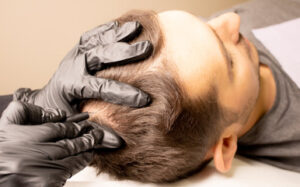Although the process of micropigmentation is similar to cosmetic tattooing, there are a few differences between the two procedures. The procedure itself is less invasive and uses a different pigment than tattoo ink. It also involves a much less advanced instrument. The process itself usually takes 20 to 30 minutes and is performed in a clinic. Most patients experience minimal discomfort. Some may opt to receive anesthesia before the procedure. If you have questions or concerns about the process, contact Scalp Micropigmentation professionals for more details.

The process itself is quick and painless. The procedure requires two to four sessions with frequent breaks. In order to minimize pigment bleeding, the operator needs to wear medical gages and take frequent breaks. Patients should arrive early for the procedure to ensure that the process goes smoothly. The procedure may require more than one session, so it’s best to discuss this beforehand. Although micropigmentation is safe for the skin, it can result in discoloration and fading after years.
In general, the procedure lasts between thirty minutes and several hours. A topical anesthetic is usually used for the procedure and a specialist will apply a cream or lotion to the area to keep it soft and promote healing. A bandage will usually be placed over the treatment area for a few hours after the procedure. In some cases, a patient may need to return for further visits if their skin is sensitive or irritated.
After the procedure, a scab will form over the pigmented dot. This scab will eventually fall off and reveal the true size of the micropigmentation dot. When the scab is gone, the treatment will resemble a hair follicle. However, some clients confuse the removal of the scab with fading pigmentation. If you are hypersensitive or have sensitive skin, you may opt for a local anaesthetic before your treatment.
A recent study published in the International Journal of Dermatology examined whether hairline micropigmentation was an effective treatment for baldness. The procedure has helped individuals with hair loss to regrow their hair, while a shaved style helps cover scarring from previous FUT (follicle-transplant) procedures. The “hair follicle” deposits blend in with the rest of the scalp. However, there are a few potential side effects of micropigmentation.
Another benefit of micropigmentation is its ability to make your lips look plumper than ever before. The pigment can be applied to the lips to replicate the effect of lipstick, but the colours will not fade. Micropigmentation is a non-invasive cosmetic procedure and can be done on both men and women. Micropigmentation involves the insertion of a tiny needle into the skin and injection of coloured pigment into the dermal layer of the skin.
Another advantage of this treatment is that it can be a safe and natural alternative to makeup. While you will always have to keep in mind that micropigmentation is a semi-permanent application, it can fade over time, so it is important to find a professional to have your procedure performed. In addition to looking more natural, micropigmentation can also enhance the appearance of your eyebrows, eyes, lips, and other areas of the body.
Another benefit of micropigmentation is that you can resume your normal routine, including using beauty products, right after the procedure. However, you should be wary of possible adverse reactions, including swelling, crusting, and minimal bleeding. Several people have reported irritation and swelling after micropigmentation. This is not a serious complication and most people will return to normal life shortly afterward. When it comes to micropigmentation, you should be cautious of the tattoo ink you choose, as you do not want it to fade away.
Micropigmentation is an innovative procedure that can provide a permanent solution to hair loss. A skilled practitioner will inject a special pigment into your scalp using a fine needle. The result is a series of tiny impressions on your scalp that resemble real hair follicles. Aside from restoring thinning hair, scalp micropigmentation can even help improve your existing hairline. This procedure is relatively inexpensive and lasts up to eight years.